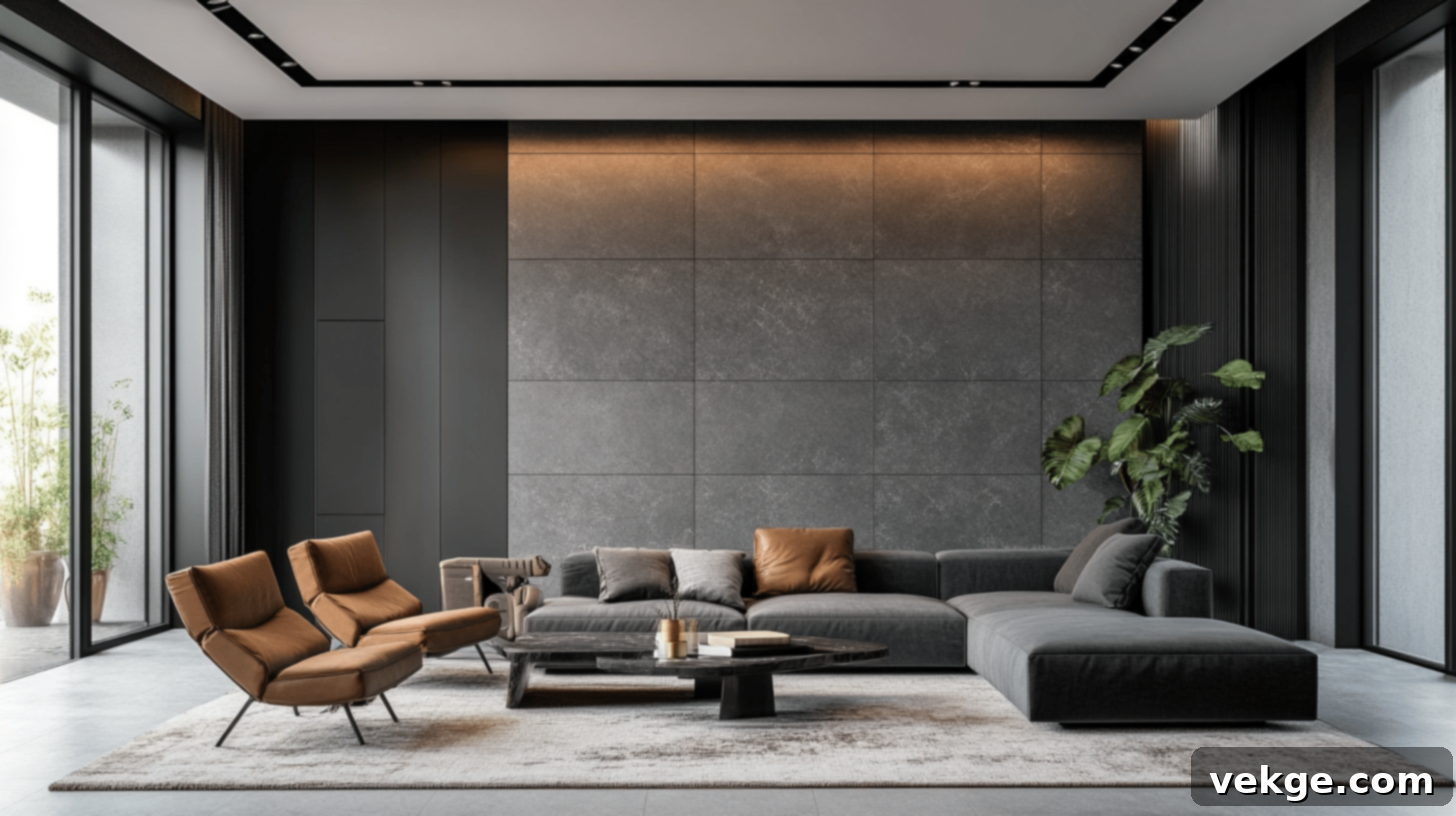Simple Wall Tiles for Living Room: 2024 Design Ideas, Trends & Care Guide
Are you envisioning a fresh, modern update for the heart of your home? The living room is where memories are made, and its walls offer a blank canvas for expressing your style. Simple wall tiles present a sophisticated yet understated approach to wall decor, offering both aesthetic appeal and practical benefits. This comprehensive guide will walk you through everything you need to know about selecting, styling, and maintaining the perfect simple wall tiles design for your living room in 2024.
In this guide, we’ll delve into:
- The compelling reasons why wall tiles are an excellent choice for living rooms.
- An exclusive look at the top tile trends shaping living room aesthetics in 2024.
- Expert tips for creatively mixing different tiles and optimizing lighting to enhance your design.
- How to confidently choose wall tiles that perfectly resonate with your personal style.
- Guidance on selecting the ideal tile size and finish to complement your space.
- Effective strategies and practical advice for preserving the beauty and longevity of your tiles.
By the time you finish reading, you will possess all the knowledge required to select, style, and meticulously maintain living room wall tiles that not only elevate your space but also reflect your unique taste. Whether you’re planning an ambitious complete renovation or simply aiming to add a striking accent wall, this guide is your essential resource for creating a truly special living environment.
Why Choose Wall Tiles for Your Living Room?
When considering home improvements, the selection of wall coverings plays a crucial role in both aesthetics and functionality. Simple wall tiles for living room spaces offer distinct advantages that make them a superior choice compared to traditional options like paint or wallpaper. Let’s explore the key benefits that solidify tiles as a smart and stylish investment for your walls.
Durability and Effortless Maintenance
One of the most significant advantages of wall tiles is their exceptional durability. Engineered to withstand the rigors of daily life, they are remarkably resilient against scratches, dents, and general wear and tear, making them ideal for high-traffic areas like the living room. Unlike painted walls that often require frequent touch-ups or wallpaper that can peel and tear, tiles maintain their pristine appearance for many years. Cleaning is a breeze – a quick wipe with basic cleaning supplies is usually all it takes to remove dust, smudges, and marks, keeping your living room looking fresh and immaculate with minimal effort. Furthermore, quality tiles resist stains and are impervious to fading from sunlight, ensuring their vibrant colors and patterns remain intact even in sun-drenched living spaces.
Aesthetic Appeal and Unmatched Customization Potential
Simple wall tiles designed for living room environments offer boundless opportunities for aesthetic expression without overwhelming the space. Their vast array of colors, patterns, textures, and finishes allows for unparalleled customization, ensuring you can find the perfect match for any interior design theme, from minimalist modern to rustic charm. Tiles create clean lines and smooth, sophisticated surfaces that contribute to a cohesive and well-designed room. They seamlessly integrate with diverse furniture styles and can be adapted to any room size, whether used to create a subtle feature wall or to cover all walls for a more dramatic impact. From intricate mosaics to large format slabs, the visual impact of tiles can truly transform a room, adding depth, character, and a sense of architectural interest.
Long-Term Cost-Effectiveness Compared to Other Wall Treatments
While the initial outlay for quality wall tiles might be slightly higher than for paint, their long-term value makes them a highly cost-effective solution. Their exceptional longevity means they don’t require frequent updates or replacements, unlike wallpaper that may need re-hanging every few years or painted walls that demand regular repainting. High-quality living room wall tiles can easily last 15-20 years, or even longer, without losing their appeal or structural integrity. Beyond their lifespan, tiles also act as a protective barrier for your walls, safeguarding them from moisture damage, minor impacts, and everyday spills, thereby reducing potential repair costs in the future. When you factor in their extended lifespan, minimal maintenance requirements, and protective qualities, wall tiles undeniably offer excellent return on investment, enhancing both the beauty and value of your home.
2024’s Best Simple Wall Tile Ideas for Your Living Room
As we step into 2024, the world of interior design continues to evolve, bringing fresh and inspiring trends in wall tiling. These simple wall tile designs for living room spaces brilliantly blend contemporary style with enduring functionality. Let’s explore some of the most captivating ideas that promise to transform your living area.
1. Modern Comfort: Grey and White Tiles
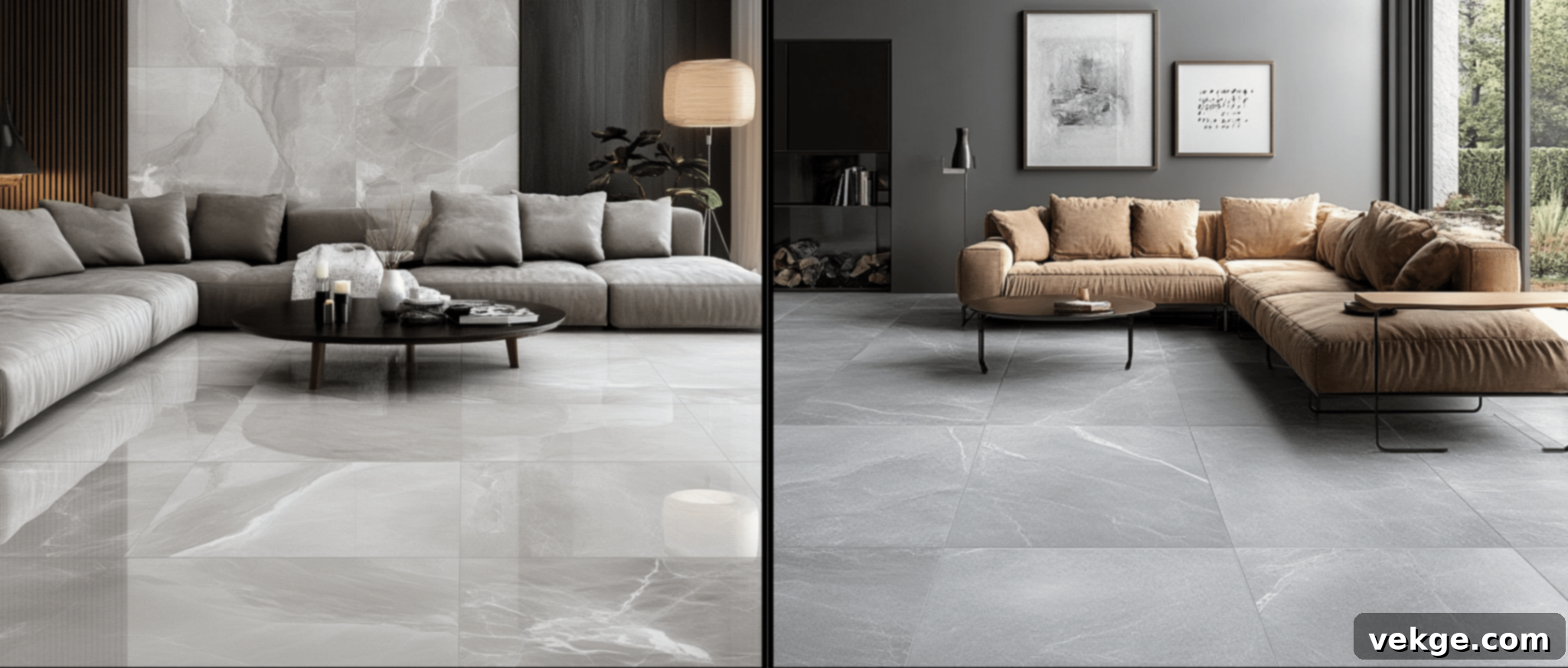
The timeless combination of grey and white continues to dominate modern interior design, offering a palette that exudes tranquility and sophisticated elegance. These simple wall tiles for living room areas are perfect for creating spaces that feel both open and inviting.
Light Grey with White Accents: Employing light grey tiles as your primary surface, complemented by crisp white accents, can dramatically enhance the perception of space and brightness in any room. This subtle interplay of tones introduces visual intrigue without overwhelming the eye. Consider using smaller white tiles to create a delicate border or a random pattern amidst larger grey ones, adding a nuanced texture and modern touch to your walls. This combination is especially effective in smaller living rooms, making them feel expansive and airy.
Multi-Tonal Grey Combinations: For a more dynamic and layered look, experiment with various shades of grey. A gradient from light to medium grey can add depth and architectural interest, making the walls a focal point without being overly assertive. Lighter greys are superb for reflecting light and maintaining an open feel, making them ideal for smaller or naturally darker rooms. Conversely, darker charcoal or slate grey tones can provide a grounding effect in larger, more open-plan living areas, lending a sense of warmth and intimacy. The key to success lies in achieving balance; mix different tile sizes and shades while diligently maintaining a clean, harmonious, and uncluttered overall aesthetic.
2. Bold and Timeless: Black and White Wall Tiles
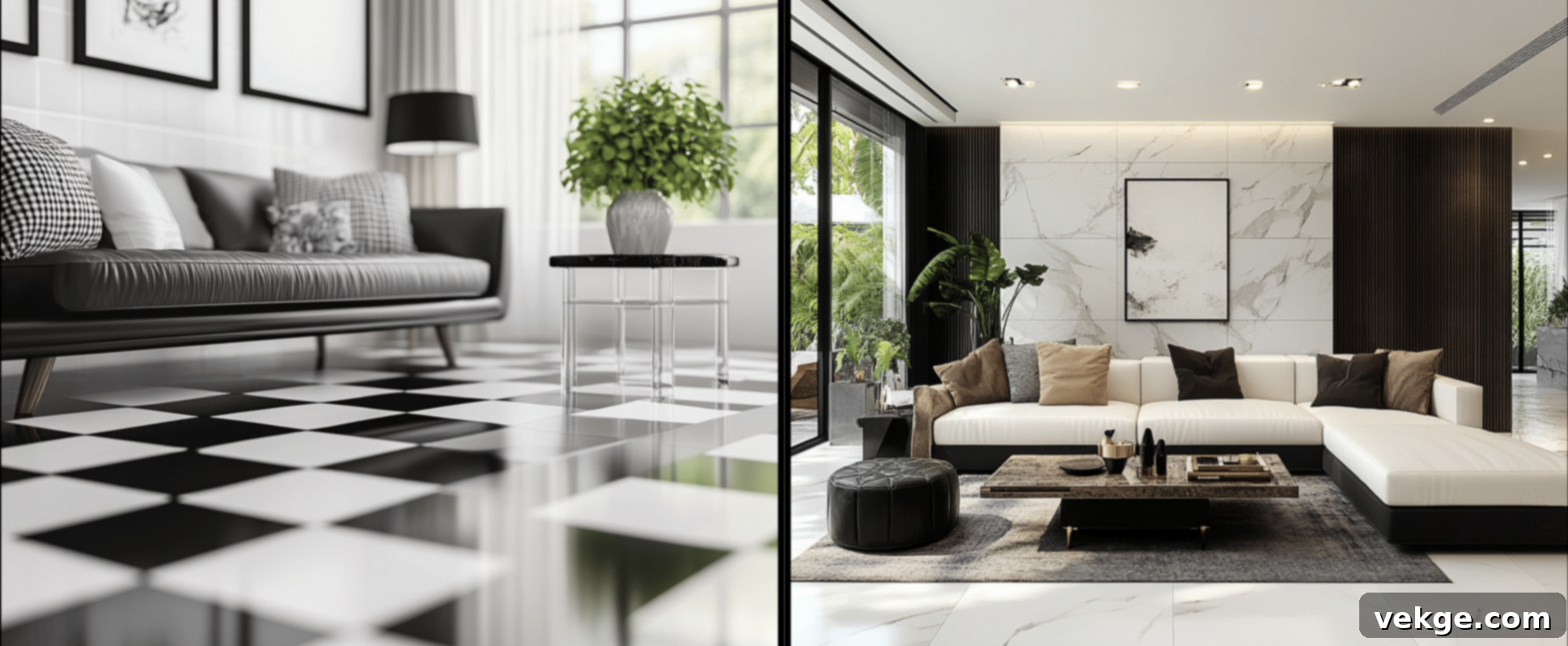
For those who dare to make a statement, the classic black and white combination offers a powerful, enduring aesthetic. Black and white wall tiles for living room areas are perpetually in vogue, providing a striking contrast that can define a space with remarkable clarity and sophistication.
Classic Black and White Contrast: The sharp, undeniable contrast between black and white naturally draws the eye and establishes a clear, decisive tone for your living room. Whether in geometric patterns, checkerboard layouts, or a more abstract design, this pairing creates a dramatic focal point. You might use small black tiles to artfully frame sections of white tiles, or vice versa, to delineate specific zones or create areas of heightened visual interest. This high-contrast approach works wonderfully in modern, minimalist, or art deco inspired interiors, adding a touch of bold luxury.
Thoughtful Furniture Pairing Guidelines: When incorporating black and white tiles, especially in prominent areas, careful consideration of your furniture and decor is paramount to achieving a balanced look. Lighter-colored sofas or armchairs will pop vibrantly against darker tile sections, creating a dynamic interplay. Conversely, darker furniture can blend seamlessly with black tiled walls for a more monolithic, sophisticated feel. Introducing natural wood furniture, whether light oak or rich walnut, can inject much-needed warmth and organic texture, softening the strong monochromatic contrast. To allow the inherent drama of black and white to truly shine, it is advisable to keep other accent colors minimal and deliberately chosen, ensuring they complement rather than compete with your tile design.
3. Chevron and Herringbone Patterns

Patterns have a unique ability to add character and movement to a room, and the chevron and herringbone layouts are leading the charge in 2024. These simple wall tile designs for living room spaces infuse architectural interest without the need for complex colors.
Gray Chevron Wall Tile: Gray chevron tiles are an excellent choice for adding a sense of sophisticated dynamism to your walls. The distinctive V-shaped pattern inherently guides the eye, creating a feeling of flow and movement across the room, which can subtly expand the perceived space. Opt for various shades of grey within the chevron pattern for added depth, or a single tone for a more understated yet impactful effect. This pattern works beautifully on a feature wall, such as behind a television or a main seating area, providing a modern backdrop that is both stylish and engaging.
Beige Herringbone Wall Tile: For those seeking warmth combined with subtle pattern, beige herringbone tiles are an ideal solution. The staggered, broken zig-zag pattern of herringbone is less angular than chevron, lending a softer, more organic feel. Beige, a timeless neutral, ensures that the pattern adds texture and interest while harmonizing effortlessly with a wide spectrum of color schemes and existing decor. It’s particularly effective in creating a cozy, inviting atmosphere in living rooms that favor natural light and earthy tones.
Colorful Herringbone Wall Tile: If your living room embraces a brighter, more eclectic aesthetic, consider introducing colorful herringbone tiles on an accent wall. This approach allows you to inject vibrant hues and playful energy into your space. When selecting colors, choose shades that thoughtfully complement or provide a striking contrast to your existing furniture and decor. To ensure the patterned wall remains the undeniable star of the show, keep the surrounding elements and the rest of the room’s decor relatively simple and subdued. This strategic balance prevents the space from feeling too busy and allows the intricate pattern to truly stand out as a piece of art.
4. Texture and Luxury: Stone and Marble Tiles
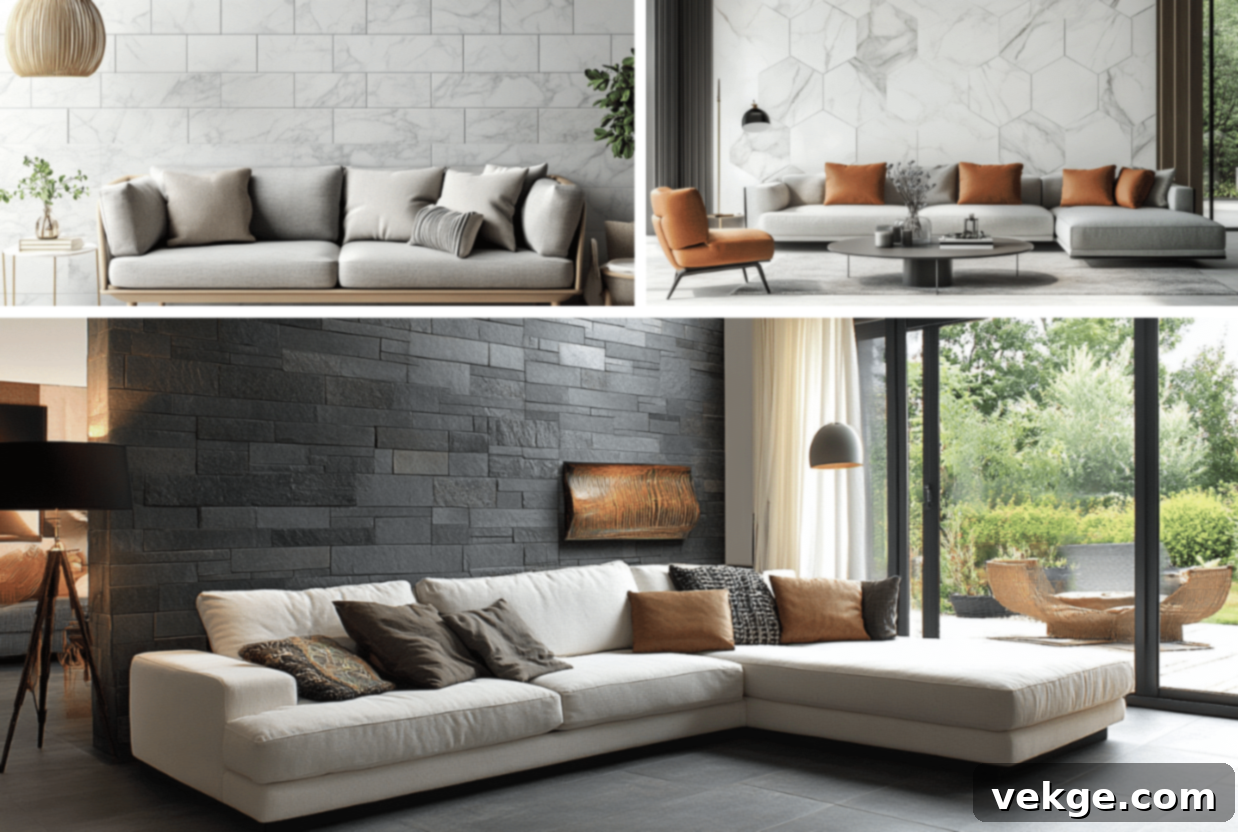
Bringing the grandeur of nature indoors, stone and marble tiles instantly elevate any living room to a realm of unparalleled luxury and sophistication. These materials are not just coverings; they are statements of timeless elegance and natural beauty.
Stone Slide Living Room Wall Tiles: Natural stone tiles, with their inherent variations in color, texture, and veining, introduce an organic, tactile beauty that is simply unmatched. Their diverse textures interact with light in fascinating ways, creating ever-changing visual interest throughout the day. From rugged split-face stone to smooth, honed finishes, simple wall tiles designed for living room walls in stone finishes exude a sense of permanence and rich character. They are perfect for creating a grounding accent around a fireplace or a feature wall that evokes the tranquility of a natural landscape, adding warmth and an earthy, sophisticated vibe.
Marble Hexagon Mosaic Wall Tile: For a touch of understated opulence, marble hexagon mosaic tiles are a superb choice. The geometric shape combined with the luxurious natural veining of marble creates an eye-catching pattern that adds intricate detail without appearing overly busy. The inherent luminosity of marble, even in smaller mosaic forms, reflects light beautifully, contributing to a brighter and more refined space. These tiles are excellent for creating a luxurious backsplash in a built-in bar area or a decorative panel that serves as a piece of art within the living room.
Marble Subway Wall Tile: The classic subway tile gains an immediate upgrade when rendered in marble. This pairing combines the familiar, clean lines of traditional subway tile layouts with the exquisite, natural beauty and distinct veining of marble. Marble subway tiles offer a refined, sophisticated take on a timeless design, suitable for both contemporary and classic living room decors. They can be laid in traditional horizontal patterns, vertically for an illusion of height, or in more intricate herringbone or basketweave styles, providing versatility and an undeniably luxurious finish that elevates the entire room.
5. Geometric and Artistic Designs
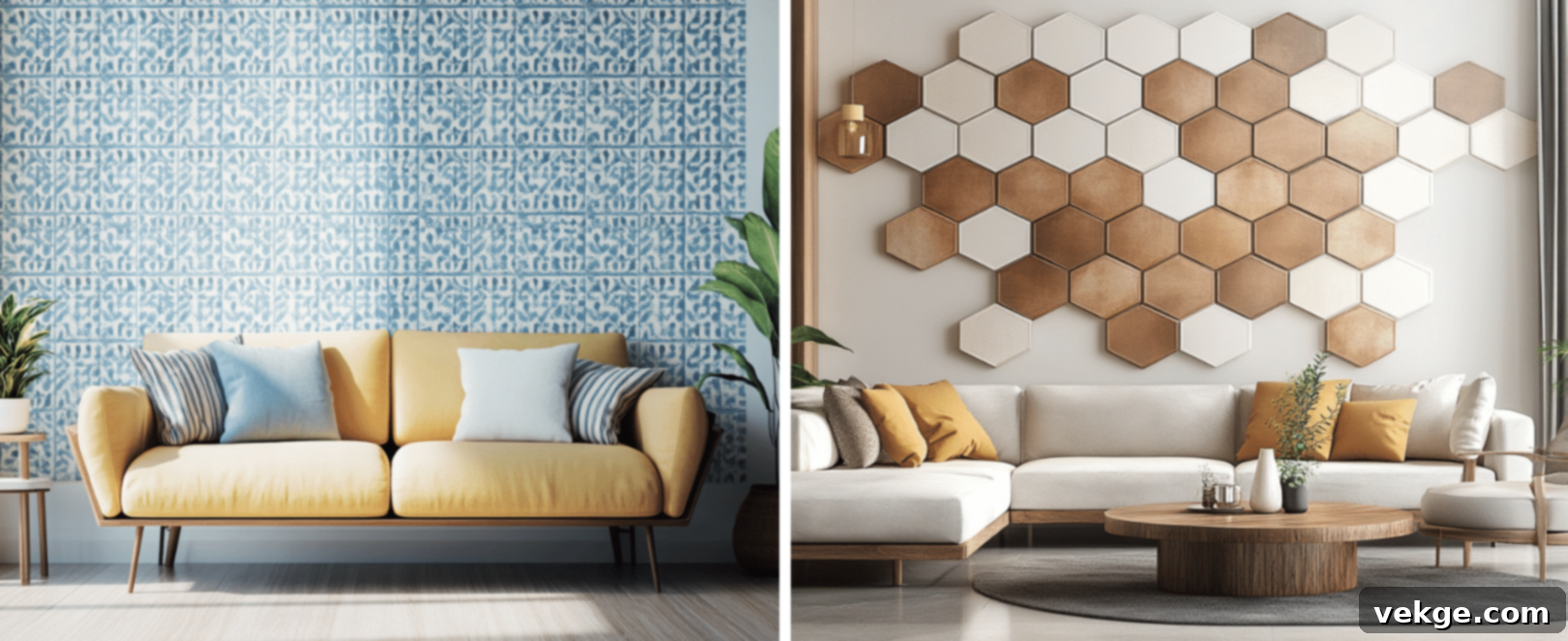
For those who appreciate modern aesthetics and a touch of artistic flair, geometric and patterned tiles offer a fantastic way to infuse personality and contemporary charm into a living room. These designs bring a structured yet playful element to your walls.
Hexagon Wall Tile: Hexagon tiles are a cornerstone of modern design, offering clean, crisp lines and a subtly intriguing pattern. Their six-sided shape provides a dynamic alternative to traditional square or rectangular tiles, bringing a contemporary edge to any space. They work equally well in both large and small formats, allowing for versatile application – a large hexagon tile can create a bold, graphic statement, while smaller hexagons can form a delicate, intricate mosaic. Use them to create a striking accent wall or to subtly define a specific zone within an open-plan living area, adding a touch of geometric precision and modern elegance.
Patterned Cement Wall Tile: Cement tiles featuring artistic patterns are an excellent way to add rich personality and character to your living room while maintaining a controlled and cohesive color palette. These tiles often draw inspiration from historical designs, offering a blend of vintage charm and contemporary artistry. To create compelling focus areas, consider mixing plain cement tiles with a select number of beautifully patterned ones. This approach allows the intricate designs to stand out without overwhelming the room. For optimal balance and visual impact, it’s often best to confine patterned tiles to a single accent wall, allowing it to become a curated piece of art that anchors the room’s design and tells a unique story.
6. Minimalist Subway Tile Walls
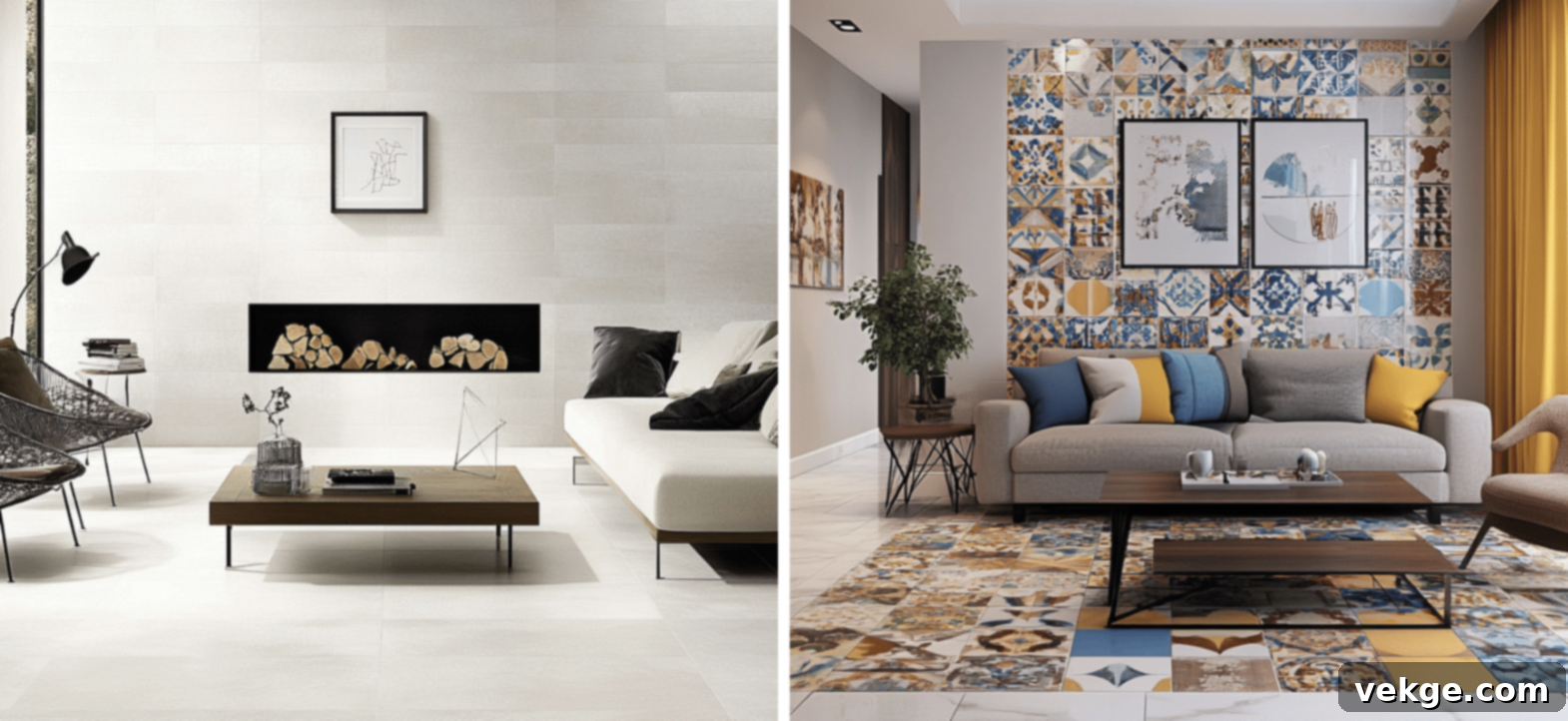
The enduring popularity of subway tiles lies in their simplicity, versatility, and ability to create a clean, crisp backdrop for any interior style. In 2024, minimalist subway tile walls continue to be a go-to for designers and homeowners alike seeking a blend of classic charm and modern sensibility.
Classic White Subway Design: Simple subway tiles are celebrated for their ability to create walls that feel structured yet incredibly welcoming. Their straightforward, elongated rectangular shape and clean lines lend a sense of order and serenity to a room. White subway tiles are particularly effective; they not only brighten any space by reflecting light beautifully but also add subtle texture and depth without introducing overwhelming visual noise. They are a perfect choice for achieving a timeless, airy, and sophisticated look that serves as a versatile foundation for various furniture styles and decor elements.
Mixed Size Layouts: To add a layer of subtle intrigue and break the monotony of a uniform pattern, consider incorporating mixed-size subway tiles into your design. This involves layering different dimensions of subway tiles – perhaps larger ones at eye level transitioning to smaller ones above, or a combination of widths within the same wall. Using contrasting grout colors with a mixed-size layout can further highlight the intricate pattern and provide a more graphic statement. For instance, dark grout with white tiles makes each individual tile pop, emphasizing the grid. When embracing this layered approach, it’s important to keep other accessories and decorative elements in the room simple and uncluttered, allowing the nuanced tile design to be the primary textural and visual focus, maintaining that desired clean and minimalist aesthetic.
Pro Tips for Enhancing Your Living Room with Wall Tiles
Achieving a truly remarkable look with simple wall tile designs for living room spaces goes beyond just selecting beautiful tiles. Thoughtful planning and attention to detail in execution are crucial for making your tile design truly shine and integrate seamlessly into your home. Here are some expert tips to elevate your tiling project.
1. Mix and Match Tiles for a Unique Aesthetic
Creating a unique and personalized living space often involves a creative blend of materials. Mixing and matching wall tiles can add depth, texture, and undeniable character to your living room walls, transforming them into bespoke works of art.
Pattern Combinations: One effective technique is to combine tiles of different sizes or patterns. For instance, you could place larger, more subdued tiles at eye level to create a stable foundation, then transition to smaller, more intricate patterns or mosaics above or below. This layering effect introduces visual interest without making the wall appear busy or overwhelming. Consider combining a classic subway tile with a section of geometric hexagons for a dynamic contrast. The key is to ensure there’s a unifying element, such as color or finish, to maintain harmony.
Color Blending: When mixing colors, aim for a cohesive palette of two to three complementary shades. Neutral tiles, such as beige, grey, or white, should typically serve as your base, providing a calming backdrop. You can then strategically introduce smaller sections of colored tiles to create subtle accents or focal points. For example, a living room with predominantly light grey tiles could feature a thin horizontal band of a darker contrasting color or a delicate mosaic in a soft blue. Remember, simple wall tile designs for living room areas achieve their best results when colors flow naturally and enhance the room’s overall mood rather than clashing.
Size Variations: Don’t shy away from mixing different tile sizes on the same wall to create dynamic texture and visual rhythm. Imagine large format square tiles paired with narrow rectangular ones, or a mosaic band breaking up larger plain tiles. When varying sizes, it’s often best to keep the colors similar or within the same tonal family to prevent the design from becoming too chaotic. This approach allows the interplay of dimensions to create interest while ensuring the overall look remains sophisticated and neat, adding a modern architectural feel to your living room.
2. Choosing the Right Grout Color
The color of your grout might seem like a minor detail, but it profoundly influences the final appearance of your tiled wall. Grout can either seamlessly blend with your tiles or create a striking contrast, defining each tile individually.
Matching Grout: For a sleek, monochromatic, and expansive appearance, opt for a grout color that closely matches your tiles. This approach minimizes the visibility of individual tile lines, making the wall appear more solid, unified, and contemporary. This continuous look is particularly effective with simple wall tiles design for living room spaces where a sense of calm, spaciousness, and understated elegance is desired. It allows the tile’s texture and overall color to be the dominant feature.
Contrasting Grout: To highlight the pattern and shape of your tiles, a contrasting grout color is an excellent choice. Dark grout used with light tiles (e.g., charcoal grout with white subway tiles) creates a bold, graphic outline around each tile, emphasizing the grid and adding a modern, industrial edge. Conversely, light grout used with dark tiles makes each tile pop, creating a vibrant pattern. When choosing a contrasting color, ensure it complements your room’s existing color scheme and furniture to maintain overall harmony.
Maintenance Considerations: Beyond aesthetics, practical considerations are important. Light-colored grout, while beautiful, tends to show dirt, stains, and discoloration more easily over time, requiring more frequent cleaning. Darker grout, on the other hand, is much more forgiving and effectively hides everyday grime, making it a lower-maintenance option. Always consider your lifestyle and cleaning habits when making your grout color decision.
3. Lighting Considerations to Highlight Tile Features
Lighting is a powerful design tool that can dramatically alter how your wall tiles are perceived, bringing out their textures, colors, and unique characteristics. Thoughtful lighting can transform a tiled wall from merely a surface into a captivating design element.
Natural Light: Observe how natural light interacts with your chosen tiles throughout the day. Place shiny, glossy, or highly reflective tiles where sunlight can hit them directly to maximize their luminosity and sparkle, creating a bright and energetic atmosphere. Conversely, in rooms that receive abundant natural light, using matte or textured tiles can help reduce glare and create a softer, more subdued ambiance. Understanding the movement of sunlight in your living room will help you position tiles for optimal visual effect and comfort.
Artificial Lighting: Strategic artificial lighting can emphasize the unique features of your tiles. Install wall lights, such as sconces or picture lights, above or alongside textured tiles to create captivating shadows and highlights that accentuate their three-dimensional quality. Uplighting from the floor or downlighting from the ceiling can also dramatically transform the perceived texture and depth of the tiles. Using warm-toned bulbs can make certain tiles, especially those with natural stone or wood-look finishes, appear more inviting and cozy, while cooler-toned bulbs can enhance modern, minimalist designs.
Light Planning and Testing: Before committing to a full installation, it’s crucial to test your tile samples under various lighting conditions. This includes daylight, evening ambient light, and any specific accent lighting you plan to use. The color and finish of tiles can look drastically different depending on the light source. Morning sun might cast a different hue than afternoon light or artificial evening illumination. Ensure you are pleased with how your tiles appear at all hours of the day and night to avoid any costly surprises after installation. Proper light planning ensures your tiles always look their absolute best.
Caring for and Maintaining Your Living Room Wall Tiles

Investing in beautiful simple wall tiles for living room spaces means ensuring their longevity and maintaining their pristine appearance. With proper, consistent care, your tiles will retain their beauty and charm for many years to come, truly making them a lasting feature of your home. Here’s a detailed guide on how to keep your tiles looking fresh and fabulous.
How to Clean Different Tile Materials
Each tile material possesses unique properties that dictate the most effective and safest cleaning methods. Using the right products and techniques prevents damage and preserves their inherent beauty.
- Stone Tile Care: Natural stone tiles (like travertine, slate, or granite) are porous and require gentle care. Clean them regularly with a mild, pH-neutral stone cleaner diluted in warm water. Use a soft cloth or sponge, and avoid abrasive scrubbers. After cleaning, promptly pat the tiles dry with a clean, soft cloth to prevent water spots and mineral buildup. Crucially, steer clear of acidic cleaners (vinegar, lemon juice) or harsh chemicals, as these can etch and permanently damage the stone’s surface, eroding its natural beauty and sealant.
- Marble Tile Upkeep: Marble, a luxurious but delicate stone, demands specific attention. Wipe marble tiles gently and frequently with a damp, soft cloth to remove dust and light smudges. Immediate action is key for spills; blot them up right away to prevent staining, as marble is highly susceptible to acid etching from liquids like wine, coffee, or citrus. For tougher spots, use specialized marble cleaners that are pH-neutral and formulated to protect the stone. Absolutely avoid strong chemicals, abrasive pads, or general-purpose household cleaners, which can dull the surface or eat into the stone, causing irreversible damage.
- Ceramic Tile Maintenance: Simple wall tiles designed for living room walls in ceramic are remarkably durable and straightforward to maintain. For routine cleaning, a mixture of warm water and a gentle, non-abrasive dish soap is usually sufficient. Use a soft cloth or sponge to wipe down the tile surfaces. For the grout lines, which can accumulate dirt, a soft-bristled brush (like an old toothbrush) and a dedicated grout cleaner can be very effective. After cleaning, dry the tiles with a clean, lint-free cloth to prevent water spots and achieve a streak-free shine.
- Cement Tile Protection: Cement tiles, known for their vibrant patterns and matte finish, are porous and require sealing. For daily cleaning, simply use plain water and a soft cloth. When a deeper clean is needed, opt for pH-neutral cleaners specifically designed for cement or natural stone, avoiding anything acidic or harsh. To protect against stains and moisture absorption, it’s essential to apply a high-quality penetrating sealer yearly, or as recommended by the manufacturer. Always keep the surface as dry as possible to maintain the crisp look of the pattern and prevent moisture-related issues.
Protecting Your Tiles from Damage
Proactive measures are your best defense against damage, ensuring your living room wall tiles remain impeccable for decades.
- Prevention Tips: Be mindful of furniture placement. Keep items that could potentially scratch, chip, or impact the tiles at a safe distance. For tall, movable furniture pieces or decor items that are positioned close to tiled walls, consider attaching soft felt pads to their edges or backs. This simple step creates a protective buffer, minimizing the risk of accidental scrapes or nicks that could mar the tile surface. Regularly inspect the area around your tiles for any potential hazards.
- Regular Checks: Integrate periodic inspections into your home maintenance routine, perhaps every few months. Take a moment to visually scan your tiled walls for any signs of loose tiles, which can indicate issues with the adhesive or substrate. Pay close attention to the grout lines; look for any signs of wear, cracking, or crumbling. Addressing small issues like a tiny chip or a deteriorating grout line promptly can prevent them from escalating into more significant, costly repairs. Re-sealing grout lines yearly is also a good practice to maintain their strength and water resistance.
- Long-term Protection: Maintaining a stable environment is key to long-term tile and grout protection. Control room humidity, especially in climates prone to extremes, to prevent issues like grout degradation or tile lifting. Swiftly address any water leaks near tiled walls, as prolonged moisture exposure can cause significant damage to both tiles and the underlying structure. Keep the room temperature as steady as possible, as extreme temperature fluctuations can also affect tile integrity over time. Finally, monitor the effectiveness of your tile and grout sealer; when water no longer beads up on the surface and soaks in instead, it’s a clear indication that a fresh application of sealer is due. Professional sealing every few years can offer superior protection.
Conclusion
The journey of selecting and styling wall tiles for your living room is more than just a renovation; it’s an opportunity to infuse your home with lasting beauty, refined style, and effortless practicality. Wall tiles offer a unique blend of aesthetic versatility and robust durability, making them an excellent investment that transcends fleeting trends. Your thoughtful choice of tiles will profoundly influence the ambiance, functionality, and overall feel of your living space every single day.
As you embark on this exciting project, remember to meticulously consider your room’s natural and artificial lighting, the existing furniture, and how you envision using the space. These elements are crucial in guiding your tile selection to ensure a harmonious and cohesive design. Paying close attention to seemingly small details, such as the color of your grout, the finish of the tile (matte, glossy, textured), and the chosen laying pattern, can make an astonishing difference in the final aesthetic impact, elevating your design from good to truly exceptional. Always make it a point to test tile samples directly in your living room, observing how they interact with your lighting conditions throughout various times of the day – this step is invaluable for making confident and informed decisions.
When chosen with care and installed with precision, good quality tile choices are designed to last for many years, becoming an integral part of your home’s character. With a routine of basic care and consistent attention, your living room wall tiles will retain their stunning appeal, vibrancy, and structural integrity for decades. Take the time to plan your design comprehensively, explore the myriad of available options, and ultimately, select tiles that genuinely resonate with your personal style and bring comfort and joy to your home.
Your living room is a reflection of your personality and tells a unique story. Let your meticulously chosen and beautifully designed wall tiles help tell that story with elegance, depth, and enduring charm.
